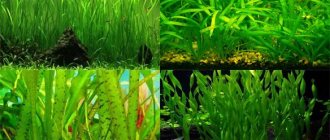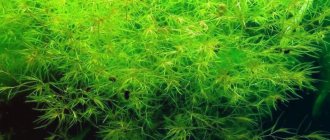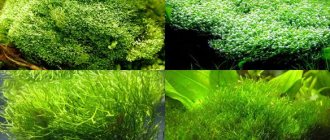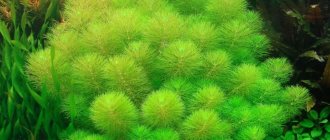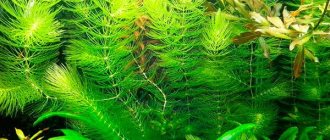Home › Aquarium plants › Catalog of aquarium plants ›
( 1 ratings, average: 2.00 out of 5)
Red Ludwigia (Ludwigia Repens) - this aquarium plant is also found under such names as Ludwigia red, Ludwigia repens.
Due to its resistance to low temperatures, Ludwigia red can be used for a home pond.
Most popular types
Depending on the species, the color of Ludwigia leaves can be different, including with a red tint. Domestication has meant that they can be kept in a variety of environments, not just warm tropical waters. Some aquarists believe that the selected forms of plants differ little from each other, and the foliage gets a different shade due to the conditions of detention. There are also unpretentious species that are suitable for breeding by beginners:
Palustris or swamp - this species loves clean water and good lighting. Given the right conditions, it will grow quickly. If you decide to plant palustris in your aquarium, then the water in it should be 22-26 degrees, with hardness from 2 to 12, acidity from 6 to 7.5 pH.
Creeping or repens is distinguished by oval glossy leaves. Its color is dark green on top, and in the lower part near the stems it becomes reddish-purple. The plant reaches a length of 30-40 cm.
Inclinata Cuban - when transferred from its habitat to the aquarium, this variety changed its appearance: its leaves elongated and began to grow as close to each other as possible.
Super Red (Super Red) - this species differs from others in its unusual leaf color. They are red in color and do not lose the intensity of the shade due to insufficient light exposure. In specialized stores you can find this variety under different names; you can recognize it by its appearance.
The Peruvian or red star is a long-stemmed species suitable for an aquarium larger than 150 liters. Due to its length, the plant is planted only along the back wall, otherwise it will obscure the view. This species changes its color depending on the conditions in the aquarium, the upper part of the leaves is usually green or brown, and the lower part is red.
Tornado is an unusual variety bred in Vietnam. It has twisted leaves growing in whorls of thick stems. The plant will be tidy only with timely supply of fertilizers, a sufficient amount of carbon dioxide and reduced water hardness.
Arcuata or arcuate is a plant with a long stem and narrow leaves arranged in pairs. If you create the right conditions, the foliage will turn brown-red. The plant grows up to 30 cm in length. For normal development, it needs to warm the water to 22-27 degrees, keep its hardness between 1 and 20, and adjust the acidity parameter from 6 to 8 pH.
Ruby - This variety is often considered a subspecies of Super Red, as they are similar in foliage color. Ludwigia ruby is distinguished by a dense brown stem, large leaves 3 cm long and 2 cm wide, and changes in color if not properly cared for.
The floating one loves the most intense light - up to 1.5 W/l. It differs from other species in its elongated stem, reaching a length of up to 1 meter. Rounded leaves are attached to it in pairs, which can only exist on the surface of the water. If you try to “drown” the plant, its foliage will quickly die off.
These are the most beautiful and common Ludwigias in home aquariums. In total, there are more than 75 variants of this plant in the world.
Maintenance and care
| Lighting | °C | Carbonate hardness (°dKH) | Total hardness (°dGH) | PH |
| Moderate-Strong | 15-29 | 2-15 | 0-30 | 5-8 |
Red Ludwigia, of course, is not as hardy as Java moss or anubias, but if the basic maintenance requirements are met, it is quite easy to maintain. The most important requirement is, of course, good lighting. This plant will not grow in low light conditions, requiring at least 0.5 watts per liter of water to thrive. In brighter light the plant will grow faster and have much more intense leaf color. In order for the leaves of Ludwigia red to turn bright red, lighting of at least 0.75 - 1 watt per liter of water is required (possibly less in brighter lighting). Also, the plant should not be shaded, otherwise it may become unsightly and the leaves will begin to die. Although the application of CO2 is not necessary, its additives and fertilizers significantly improve growth and coloration. The addition of nitrogen, phosphorus and iron has a particularly beneficial effect on this aquarium plant.
Ludwigia can be uprooted by fish, so you should not keep it with fish that like to dig and dig up the soil. If you provide Ludwigia with good lighting and nutrition, then you will not have any problems with it, and soon you will need haircuts for correction.
Optimum temperature for normal growth: 23° - 27° C, medium to strong lighting, 0.5 to 1 watt per liter of water. The color of the leaves can be red even at 0.5 watts per liter of water, provided there is sufficient fertilizer and CO2. Additional requirements : it is desirable to add CO2 and fertilizers.
How to keep a plant
A feature of Ludwigia is its uniform development and growth throughout the year. This plant can be planted in an aquarium of any size. In large containers it is planted near the rear or side walls. It is necessary to create optimal tropical conditions:
| Conditions of detention | Recommendations |
| Climate | The optimal water temperature should range from 20 to 28 degrees. |
| Hardness and acidity | These water conditions are not particularly important for ludwigia. The plant tolerates weak acidic and alkaline environments well. With a hardness of more than 8 dH, the color of the foliage becomes more intense. |
| Updating fluid volume | It is recommended to change up to 30% of the total water volume once a week. |
| The soil | You can choose whether to root the plant or leave it floating on the surface. If you plant it in the ground, Ludwigia will develop faster. |
| Lighting | It must be diffuse. Aquariums located near a window or equipped with weak lamps work well. With this lighting, the redness will disappear from the leaves and a rich green tint will appear. They will look more attractive. If you choose fluorescent lamps, their power should be 0.5 W/l. You can add a 40 W incandescent lamp to the aquarium. The duration of light for Ludwigia should be at least 12 hours. |
Proper care allows the plant to develop as quickly as possible. You can determine whether you have truly created optimal conditions by the color of the leaves.
Description
The aquarium plant Ludwigia is found in many home ponds. It not only decorates the aquarium, but also creates an optimal microclimate for the fish.
Ludwigia stands out even in the herbal book!
Ludwigia belongs to the fireweed or onagraceae family. The plant's habitat is quite extensive: Central and North America, Africa, Asia, Europe. Ludwigia prefers warm waters and can grow both on land and in water.
Distinctive features of Ludwigia:
- straight, curved stem up to 0.5 m long;
- branched shoots;
- numerous leaves.
The size, shape and color of the foliage depend on the species of the plant and the conditions of its maintenance. The color of the leaf blades varies from light green to purple.
With proper care, Ludwigia can bloom above water, which allows you to create unusual compositions from it in the aquarium. The main thing is to create suitable conditions for the plant.
How to plant
It is best to plant this plant in low aquariums, since it develops better at low water levels. Aquarists plant ludwigias in different containers, focusing primarily on the inhabitants and the conditions of their detention.
Rooting of Ludwigia is not required. She can float freely on the surface of the water. If you nevertheless decide to plant it in the ground, then you need to select coarse sand with a small amount of silt. Please note that you should not plant Ludwigia in an aquarium that contains fish that like to dig in the soil - they will damage the root system.
It is permissible to use gravel, but only fine gravel. If its diameter is too large, the delicate roots of Ludwigia will be damaged. Be sure to mix the soil with fertilizer in the form of clay balls and special tablets. The nutritious part of the soil should cover the bottom of the aquarium by 3 cm, and gravel and sand should be laid on it. The total thickness of the pillow should be no more than 5 cm.
Aquadesign
Ludwigia repens is commonly used as a background plant to add a red accent to the aquarium. Several cuttings grouped together will create a beautiful red and dark green forest at the back of the aquarium. But with the right regular trims, it can be used in the middle part of the tank and even in the foreground of a large aquarium. If you cut off the top of the stem, side shoots will begin to grow from the base and the plant will become bushier in appearance. If you cut the bottom off, the stems will continue to grow upward instead of outward. In a large aquarium with very strong light, you can use this aquarium plant for the foreground and encourage bushy growth with trimmings. However, this option is only recommended for experts, since in strong light conditions you will have to do regular trimming to keep the plant at the bottom of the aquarium.
The most important thing is to never place this plant in shaded areas of the aquarium, since Ludwigia will stop growing and gradually simply disappear. Therefore, it is not recommended to plant it next to plants with broad leaves, such as Echinodorus amazonica.
Features of planting for greenhouses
If you have a paludarium or greenhouse with high humidity levels, you can make Ludwigia a ground plant. It can develop in such conditions if the air is very humid and the lighting is diffuse.
To plant ludwigia as a terrestrial plant, you must first place the cutting in a container with a low level of water. After it takes root and produces new stems, you need to place it in a pot with a nutrient mixture. Humus with sand, peat or garden soil are suitable.
Use in aquarium design
Ludwigia is a very beautiful plant with high decorative value. The aquarium, which contains its plantings, is truly transformed, acquiring a natural, natural appearance.
Algae are planted on soft ground in small groups of about 5 branches. In this case, the most successful location is the center of the container - the middle plan. Some species can go beyond the water and grow in the air, hanging from the walls of the aquarium, which gives it a very unusual appearance.
In some cases, a plant is bred without rooting, when it simply floats in the water column. Although it may look rather unusual, keeping a Ludwigia this way is not good for it. After some time she may die.
Reproduction
If you want to plant ludwigia, then you need to separate a shoot at least 10 cm long from the stem. It can be immediately planted in the ground or left to float on the surface of the water until it takes root. After this, plant the plant.
Ludwigia quickly takes root and reproduces easily. This is why beginning aquarists love her. It is well suited for those who are going to make an additional aquarium for spawning fish. Roots appear on the shoots within a few days.
Planting
Aquarists need to know that Ludwigia “ruby” develops quite quickly, combining with many familiar plants. From the point of view of aquatic landscape design, it is better to place it in the center of the aquarium against the backdrop of its green neighbors, making sure that they have different shades and leaf shapes.
Side shoots and aerial roots of Ludwigia can quickly fill the space, so they need to be removed periodically. This operation is painless for her, and the result is new planting material.
The cuttings can be immediately placed in the sandy layer of the aquarium, slightly deepening them.
If the aquarium has a drainage layer, small branches of Ludwigia can easily take root in it and begin to grow. The only condition for life in this situation will be the size of the drainage fraction - the smaller, the better.
If the volume of the aquarium is less than 80 liters, Ludwigia can be placed in a special pot, attaching it to the wall of the aquarium and not forgetting about high light conditions for the plant.
In this case, you need to make sure that it does not become too large, since intensive growth can lead to very rapid withering - the lower leaves begin to rot, and then the cuttings fall out.
Why isn't it growing?
There are several reasons why Ludwigia starts to get sick and stops developing:
- malnutrition;
- lack of lighting;
- too cold water in the aquarium;
- dirty water.
As soon as you eliminate the cause, the plant will begin to grow rapidly and change the color of the leaves. It is necessary to focus on the characteristics of the content of the Ludwigia variety, only then you will be able to admire the plant for a long time. Some species like harder water, others need it very warm, and the floating species is demanding on lighting.
Ludwigia disease: symptoms, causes, treatment
Almost all diseases of all types of ludwigia are associated with violation of the rules for the care and maintenance of this plant in the aquarium. Exceeding the acidity and hardness of water, insufficient filtration, aeration and regular water renewal very often leads to the death of the plant.
The lack of optimal additional lighting also causes Ludwigia to feel discomfort and show various signs of disease - yellowing and paleness of the leaves, the appearance of holes on them, the plant being covered with green, red or brown algae, and much more.
Sometimes the causes of Ludwigia diseases can be the poor condition of the soil, which needs to be replaced or thermal disinfection carried out in order to destroy the pathogenic flora.
Very often, ludwigia diseases are caused by a lack of mineral components in water, containing nitrogen, potassium, calcium, magnesium, iron or phosphates. To prevent this, it is necessary to carry out timely and competent feeding of Ludwigia with special complex aquarium fertilizers.
By following all the above rules for maintaining and caring for Ludwigia, you will be able to enjoy the extraordinary beauty of this ancient exotic plant for a long time.
Fertilizers
Most ludwigias are picky about fertilizers. They need special mineral supplements. The plant needs to be fed from the moment of planting; for this purpose, the soil is mixed with small clay balls.
One of the important elements for the development of algae is iron. It allows you to preserve the intense color of the foliage. It is especially important to add fertilizing with this element to the aquarium: if you have chosen a plant with red leaves, they need iron the most. It is recommended to regularly feed Ludwigia with mineral fertilizers; such complexes contain everything you need.
Name variations
There are several alternative names:
- Ludwigia aff. Glandulosa;
- Ludwigia sp. "Weinrot";
- Ludwigia sp. "Red wine".
Unfortunately, confusion in the systematization of this hybrid has led to the spread of incorrect names for Ludwigia Rubin.
Incorrect names:
- Ludwigia Creeping;
- Ludwigia repens "Rubin";
- Ludwigia Glandulos;
- Ludwigia "Super ed";
- L. glandiosa.
This plant is often confused with Ludwigia Red. But they are hybrids of completely different species. The Ruby subspecies has larger leaf blades, which become lighter when there is a lack of light. The Red subspecies is distinguished by its constancy of color and smaller leaves.
Alternanthera sesilis
The process of adaptation to water conditions is not hampered by the falling of the lower leaves, since new ornamental bushes are formed. With sufficient lighting in the aquarium, the upper side of the leaf is usually green, the lower side is light green or pinkish; in partial shade or shaded areas - olive-brown and violet-red, respectively. But, unfortunately, this plant has a less intense red color than other Alternanthera species cultivated in our country. It grows equally well in shaded areas and in direct light. Sufficiently mature, well-formed parts of the stems that have at least four pairs of leaves should be planted in the aquarium. This is the only species of the genus that reproduces quite quickly under water, forming powerful bushes. Groups of 10–15 plants look most attractive. They are good for decorating the back walls of small aquariums. In large species aquariums, groups of alternanthers are placed in the middle part in free places, where they form islands with an area of 20–30 square centimeters. Alternatera sessile is characterized by the fact that in its terrestrial form it has a dense, highly branched stem, and in conditions of low humidity it is creeping. The seeds are small, whitish.
Alternanthera sessilis var. lilacina is found in warm areas around the globe. This plant adapts well to different forms of existence and can grow both underwater and on land. The color of plants is very variable and depends on cultivation conditions. Usually the upper side of the leaf is olive green, the lower side is dark red to purple. But sometimes forms appear in which the leaves on both sides are colored intense red. In the middle zone, the plant can be successfully cultivated in open ground in summer. To keep it in an aquarium, this alternanthera must be grown in conditions of high air humidity (85–95 percent) in a tropical paludarium at a temperature of 20 to 30 ° C. Young, not yet flowering shoots, when planted under water, easily take root and relatively rarely die. The plant is insensitive to the chemical composition of water, tolerates both partial shade and excess light equally well, the optimal pH value of water is about 7. The basic rule when growing this alternanthera is to create fairly stable conditions in the aquarium. It grows well in crystal clear water without algae. Alternanthera sessilis var. rubra is an emergent plant and can be easily cultivated in a moist paludarium. It grows very quickly: in 3–4 weeks the stem reaches a length of 15–20 centimeters with a large number of leaves. The underwater form forms branched creeping stems above the ground, and only a third of them straighten and also begin to branch strongly near the surface of the water. In general, they reach a length of 50–60 centimeters. The leaves are opposite, 3.5–5.0 centimeters long and 0.8–1.7 centimeters wide. On both sides they are painted ruby red. The stem is also red.
Pressed to the ground with a pebble, it forms a large number of white roots in the place of an independent pair of leaves and takes root easily. The flowers are completely sessile, red or pink; they appear in the axils of the opposite pair of leaves. Since this plant comes from the tropics, it begins to bloom around the equinox, when there is 12 hours of light per day, that is, the length of a tropical day. These plants are usually planted in an aquarium in groups of 3–5 or more shoots. The most suitable place is in the middle part of the pond, where they are placed in front of taller green and yellow-green plants. Under water, they take root within ten days, but subsequently they do not grow as quickly as in a paludarium, and retain their decorative appearance well for 2–6 months. When the leaves begin to fall, the plants should be replaced with new ones. To do this, you need to have an additional greenhouse, growing new adult plants from cuttings in it, which need the highest possible air humidity and diffused lighting. In aquarium conditions A. sessilis var. rubra needs good light and slightly acidic water.
Alternanteras are amazingly beautiful plants that serve as decoration for decorative aquariums. They also look great when cultivated in open reservoirs of garden plots, where you can create compositions with both aquatic forms and those that have emerged to the surface of the water and rooted on coastal soil.

